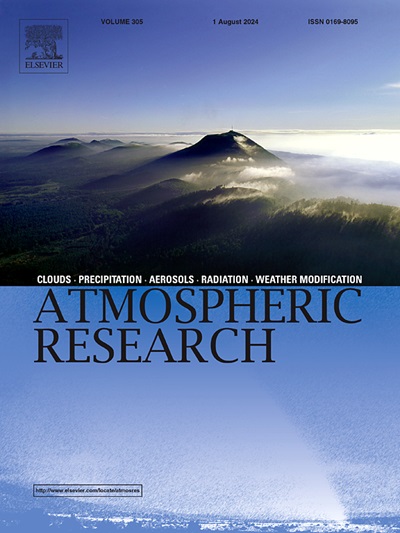Space and ground-based measurements of negative cloud-to-ground strokes with and without significant continuing currents
IF 4.5
2区 地球科学
Q1 METEOROLOGY & ATMOSPHERIC SCIENCES
引用次数: 0
Abstract
We examined the responses of the Geostationary Lightning Mapper (GLM) onboard the Geostationary Operational Environmental Satellite-16 (GOES-16) to 174 negative cloud-to-ground (CG) return strokes in 77 flashes that occurred in Florida in 2018–2023. We recorded these strokes on high-speed video cameras from which we measured the continuing current durations. The GLM flash and stroke detection efficiencies were 80.5 and 50 %, respectively. The nighttime stroke detection efficiency was 2.4 times higher than that during the daytime (81.3 versus 33.9 %, receptively). The detection efficiencies for first strokes and single-stroke flashes were 31.3 and 30 %, respectively, which were lower than that for subsequent strokes (61.7 %). The GLM stroke detection efficiency did not depend upon the return stroke peak current reported by the U.S. National Lightning Detection Network, but it was significantly higher (64.9 versus 37.5 %) for strokes with significant (>3 ms) continuing current durations versus those without (<3 ms) such currents. Continuing current durations estimated from the GLM data were significantly underestimated and were unrelated to those measured from video camera records; none of the GLM-derived continuing current durations exceeded 6 ms, while those obtained from video camera records ranged from 0.28 to 685 ms. GLM Level 0 versus Level 2 data comparison indicates that onboard and ground processing techniques applied for noise removal may be responsible for continuing current duration underestimation and reduced first-stroke detection efficiency, respectively.
求助全文
约1分钟内获得全文
求助全文
来源期刊

Atmospheric Research
地学-气象与大气科学
CiteScore
9.40
自引率
10.90%
发文量
460
审稿时长
47 days
期刊介绍:
The journal publishes scientific papers (research papers, review articles, letters and notes) dealing with the part of the atmosphere where meteorological events occur. Attention is given to all processes extending from the earth surface to the tropopause, but special emphasis continues to be devoted to the physics of clouds, mesoscale meteorology and air pollution, i.e. atmospheric aerosols; microphysical processes; cloud dynamics and thermodynamics; numerical simulation, climatology, climate change and weather modification.
 求助内容:
求助内容: 应助结果提醒方式:
应助结果提醒方式:


